Washington and Lee yearbooks depicted blackface too
A review of old Calyx yearbooks archived in Special Collections showed racist photos, jokes and drawings, as well as references to sexual assault.
February 27, 2019
Virginia politics have been plagued with scandals the past month, from the governor and attorney general’s histories of blackface to sexual assault allegations against the lieutenant governor.
Recent events have prompted national research into old yearbooks in colleges and universities across the southern United States, and the findings have shown it’s not specific to Gov. Ralph Northam or Eastern Virginia Medical School.
Washington and Lee University also isn’t exempt.
A review of archived Calyx yearbooks shows multiple photographs depicting blackface, minstrel shows and racist jokes and drawings. However, none of the individuals in the photos were identified by name.
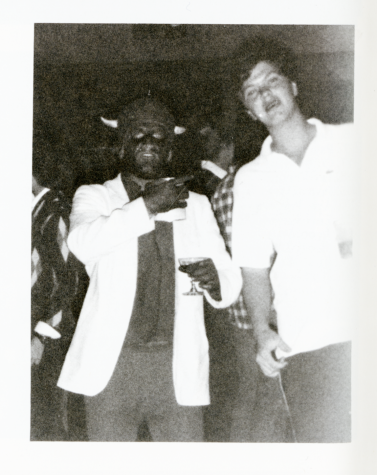
After news broke about Northam and a national reporter reached out to the university’s Special Collections, the department, including staff members and students, started an internal review of archives and isolated ones that displayed blackface. The Ring-tum Phi reviewed the seven yearbooks that Special Collections identified: 1898, 1926, 1928, 1941, 1955, 1958 and 1982.
The most recent image that Special Collections flagged was in the 1982 yearbook, on the Phi Kappa Psi fraternity page. The editor-in-chief of the Calyx that year was John T. Huskin, Jr., ‘83.
Huskin said he vaguely recalled including the photo, but that he didn’t see it as blackface.
“When I looked it up, I initially thought it was someone dressed up as the devil, as red would reproduce as black,” he said in an email. “More likely it appears to be someone dressed up as a bison. I don’t think I would have perceived this as representing or demeaning someone of color.”
Other photos from previous years showed student organizations, such as a theatre group, the Troubadours, that performed minstrel shows.
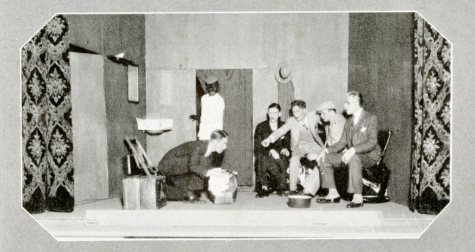
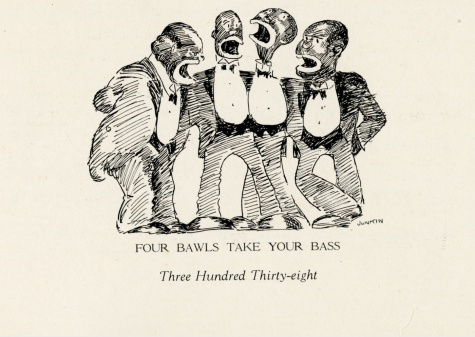
The minstrel shows continued into the 1950s.
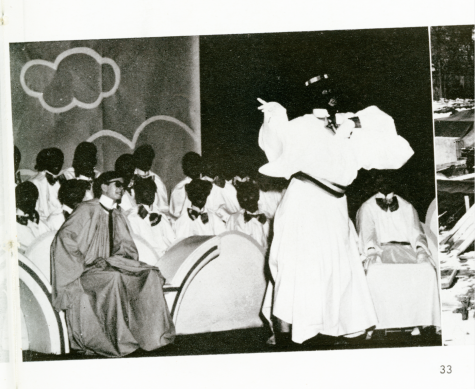
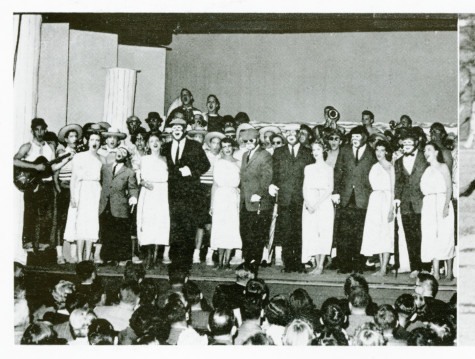
The second and third images were both from 1958—the same year Louis Armstrong performed on campus.
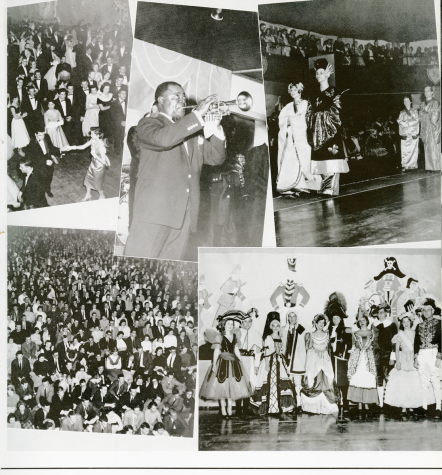
Others were from Mock Convention, such as these images of men in blackface, representing South Carolina and Louisiana for the Republican Convention in 1940.
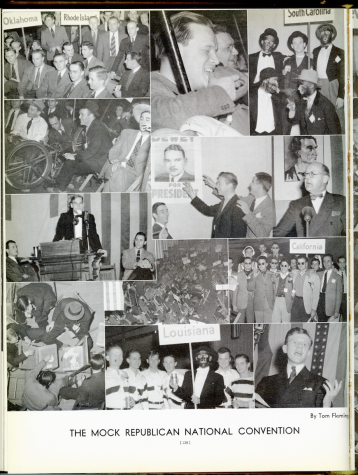
A drawing featured in the 1928 yearbook shows two Ku Klux Klan members standing next to a lynching of a black person. The quote from Henry W. Grady, a Civil War-era journalist, reads, “He finds his home in ruins, his farm devastated, his slaves free, his people without law.”
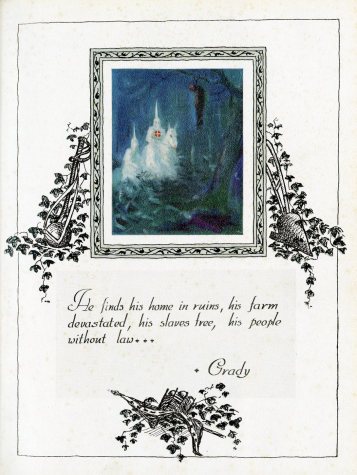
But this image didn’t originate with Washington and Lee University, or even the Calyx. The same stock image with the Henry W. Grady quote was also published in 1930 in both Middle Tennessee State University’s Midlander yearbook and Birmingham-Southern College’s La Revue yearbook.
Tom Camden, the head of Special Collections and Archives, said this image from the yearbook has never been made public before. The first time he came across it, he said it turned his stomach.
“My very first thought was, ‘Oh, that needs to go away. That needs to go in the trash. That needs to be buried,” Camden said. “But that’s not how we do things here…We will not, we cannot repress.”
The only archives that have restricted access, he said, are ones from donors who specifically requested it. Otherwise, the archives are open for public access.
That same issue includes drawings of a Confederate flag, African-Americans picking cotton in a field, an actor in blackface from a troubadour show and the following joke in the humor section:
“A negro mammy had sent her little Rastus to the spring for water. A few minutes later she happened to look out the window and saw her little off-spring tearing across the field as fast as his short, black legs would carry him. He dashed into the house with his face the color of putty and his hair standing on end. Mammy: ‘Chile, how come you didn’t bring mah wata’?’ Rastus: ‘Mammy, dey is a alligator in de spring.’ Mammy: ‘Go way, boy. Dey ain’t no alligator in dat spring. Go get mah wata’. Even if dey is a alligator in dat spring, don’t you know he would be just as ‘fraid of you as you is of him, Rastus?’ Rastus: ‘Well, mammy, if dat is so dey ain’t no use of me going afta’ no wata’, ’cause if dat alligator is as scared of me as I is of him, dat wata’ ain’t fit to drink by now.”
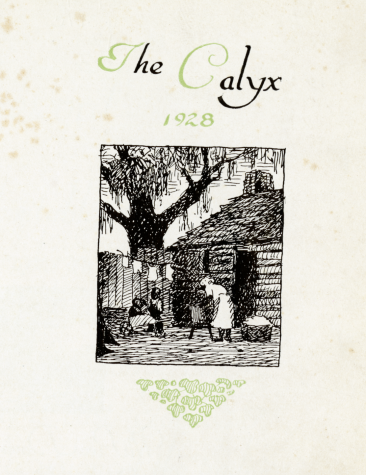
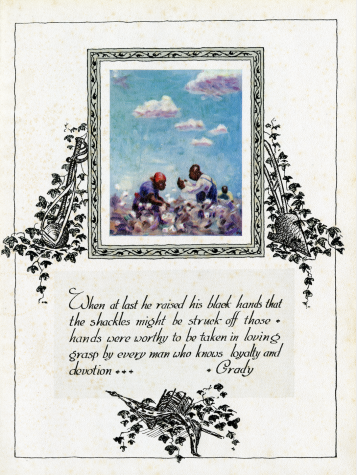
Camden said it was important to contextualize the findings with the time period.
“If you think about the public climate of our region in the ‘20s, we’re talking about the height of Jim Crow,” he said. “We’re talking about a period where, as awful as those images were to us today, how they just kind of assault your sensibilities. How inhumane is that? Why was that not obvious?”
He added that this is especially hard to do with issues of racism and sexism.
“If you look at the tenor of the times, you’ll have a better understanding about how it happened without anybody questioning it,” Camden said. “But that doesn’t make it any less reprehensible.”
Some of the jokes referenced sexual assault. From the 1926 issue: “Broken Bottles: It’s better to flask’er before you ask’er.”
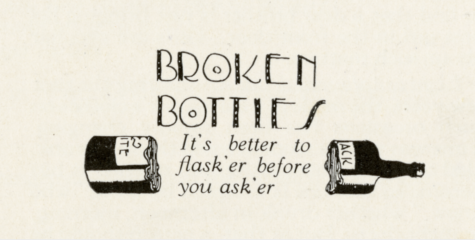
Another joke featured in the 1928 issue depicts a man holding a woman on his lap with the following caption:
“Mary: ‘John, keep your hands off me.’
John: ‘Aw, Mary, haven’t you a heart?’
Mary: ‘Sure, but you have been looking for it long enough now.’”
The first class of female students entered the university in 1985. The Board of Trustees had voted the year before 17-7 in favor of coeducation, according to the university website.
A Washington Post article published in 1990 about Virginia Military Institute’s move toward coeducation described similar fears that women would ruin tradition at Washington and Lee five years before.
“For much of the school’s history, the social life focused on weekend excursions to nearby women’s colleges such as Randolph-Macon, Hollins, Mary Baldwin or Sweet Briar,” reporter Peter Barker wrote in the article. “But with the advent of coeducation, three sororities have been formed at the university, and ‘going down the road’ is no longer the chief pastime. ‘The quality of girls here is just obviously so much better,’ explained senior Travis Blain, 21, as he gulped a beer outside the Beta Theta Pi fraternity house with music blaring last weekend.”
Barker described the shift from viewing women only as fraternity formal dates to equals in an academic environment, which proved itself: with the admission of women came higher scores and selectivity.
As a historian, Camden said he wanted to emphasize the necessity of programs like the Working Group on the History of African Americans at W&L and the Commission on Institutional History and Community in the face of conflict: from the Confederate battle flag in Lee Chapel, to the Charlottesville rally, to the present situation.
“This is part of our past,” he said. “We need to talk about it. Civil discourse is the answer. Civil discourse is always the answer. But the argument can be made that, ‘Yes, civil discourse is the answer, but there comes a point where you have to stop talking and take some action.’”
Calyx editor Kate Flory, ‘21, did not respond to requests for comment.
Special Collections Assistants Seth McCormick-Goodhart and Byron Faidley contributed to research for this story.



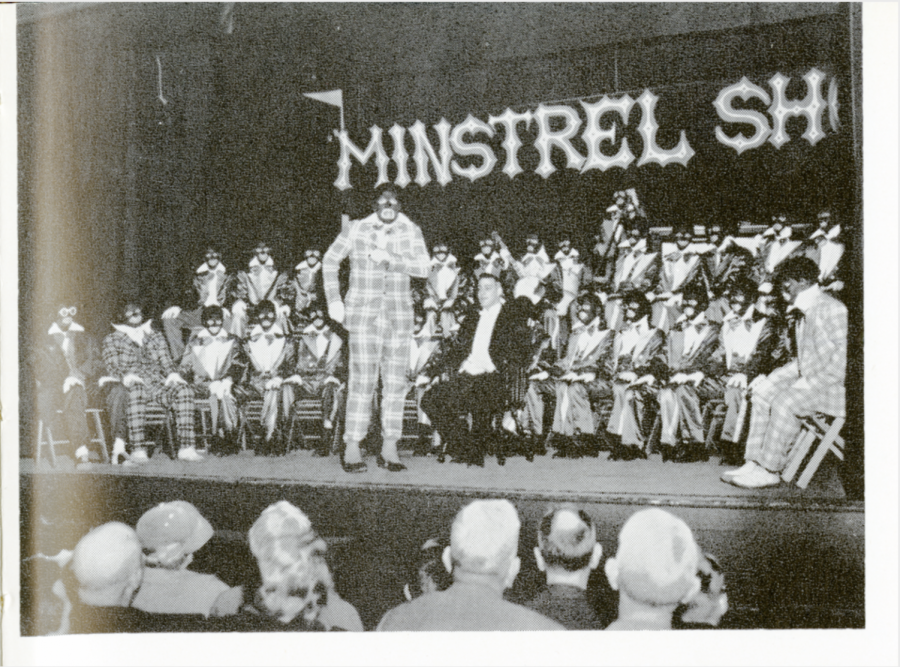
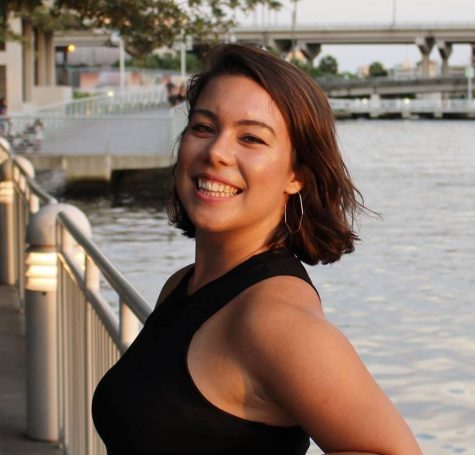
Gil T. Weitman • Mar 18, 2019 at 1:51 pm
So, you just take John Huskin, Jr ’83 at his word that the picture from 1982 is not an example of blackface? What would you expect him to say? Yes, I was the editor who negligently allowed a frat boy in blackface to be pictured in the Calyx? Of course, he would deny it!
Moreover, you could find nothing between 1958 and today that could expose the racism, misogyny and patriarchy that taint the past of the university? One picture that could be misinterpreted? That’s it? I suggest you look deeper and harder in those old texts. It should not be hard to find myriad examples of bad behavior.
How else do you expect to effect positive change? You want a more inclusive and more diverse future at Washington and Lee? You have to work harder than that. At this rate, Lee will be immortalized on the campus forever.
Eric Stratton • Mar 14, 2019 at 10:32 pm
How embarrassing. Watching a current student journalist desperately search for racist photos from decades gone by. Breathlessly hoping to see a money shot photo a la governor Ralph Northam (D).
And, the lone photo you could find in the past 60 years was clearly not a blackface photo.
This photo was taken at the legendary Phi Psi heaven and hell party. Which is why Sparky is dressed as the devil. Horns. Get it? A bison? Seriously?
So keep poring through those yearbooks and special collections. Maybe you can find a relic that will embarrass the school or an alum. Is that what you are pining for?
Alex Christensen • Mar 14, 2019 at 7:36 am
I did not intend a double entendre about Dr. Futch, a platonic friend and professor of mine. He sought me out as a student to transcribe letters in the archive about gay history for independent study credit in the nineties, I should have said more clearly.
Alex Christensen • Mar 14, 2019 at 7:27 am
The yearbooks show a relatively unselfconscious reflection of our University over the years in context with other historical documents. Made, edited by and starring the changing student body, they are a unique resource. My name appears in three of the yearbooks from my time and my picture is in all four. Some history does disappear or get erased. I’m extremely proud of what I’m pictured doing, being involved and earning my degree.
I am a Robert E. Lee Honor Scholar graduate in Independent Work (Cinema Studies). I read tons of old Southern Collegian magazines before I and other students restarted it for a couple of years as a progressive humor/literary/commentary magazine (maybe every old Southern Collegian, at least hundreds). I did gay history studies in Special Collections under Dr. Jefferson Davis Futch III in the late nineties. I looked at old, and of course, the current yearbooks when I was there and I’ve looked at them and more again recently. I’ve seen a lot of what is in the archives and I agree with you, some of it could blow a lot of minds.
I’m not complaining about the yearbooks, I’m talking about them. I don’t think they should be erased. It doesn’t matter if I am personally offended about the yearbooks overall, which would be a very silly way to look at them in total. They reveal a lot, and about important issues the University has done and is doing a pretty good job of confronting, but not yet nearly enough. I haven’t ever made a donation to Washington and Lee University, but I hope to be able to donate to the University soon, taking into account its direction going forward. It has a fascinating history and a strong legacy of honor which can be extended far into the future.
RD Lackey • Mar 12, 2019 at 6:46 pm
Alex, I think it is still the same issue. What do you want to do about a 2009 (or any year for that matter) yearbook that offends? You can’t recall them all. You can’t put stickers in them. The people in the yearbooks are off living their lives. Does the University need to run them down and chastise them? Should the University issue a blanket apology for everything anybody may have done that is offensive (which I would find offensive). I was trying to make the point that there are plenty of problems around that can be fixed. Why worry about something that can’t? This doesn’t even rise to the level of all the public monuments that folks have to look at every day. To be offended by things are in the yearbooks you actually have to go looking for them. I don’t know if you are associated with the University in any way, but if things in the yearbooks offend, the stuff in the special collections section of the library really will blow your mind. However, all that stuff is now history, and you simply can’t erase it. I guess I have stirred up a bit of a kerfuffle here but my point, again, is that I am of the opinion that we ought to expend efforts to fix what we can agree is broken, and not expend resources on things that cannot. (Not that I agree this is what the University has been doing, of course.)
Alex Christensen • Mar 12, 2019 at 9:39 am
Racist images did not disappear after the 1982 yearbook. As the article states, yearbooks are publicly available (up to 2009 so far, as I discovered). Take a look. I’ve looked at years worth up to 2009. You might not believe it.
RD Lackey • Mar 2, 2019 at 3:33 pm
Actually, I think the point, which apparently was too subtle for you, is that what is pictured in yearbooks in the 60s (my period, I did say more than 30 years), the 70s and the 80s don’t have much relevance to what is going on today. My guess is that no one, and I mean no one, looked at the yearbooks from those days until the ruckus over the current governor sent the rest of the university progressives looking at past yearbooks. It isn’t political correctness, although the university is clearly well down that road as of late, it is simply a question of “so what.” Are you going to collect all the offensive yearbooks? Should the university issue a blanket apology for everyone who may have been offended, even though they didn’t know such things existed. My guess is that in the special collections section of the university library there are many, many things that probably would offend some one. Does the university need to spend more of its money to hire someone to search through those and put disclaimers on things that might be offensive? The point, so that it isn’t too subtle for you, is that there are plenty of problems that need attention beyond what is found in decades old yearbooks, or, dare I say it, in the name of a building.
Mr. T • Mar 2, 2019 at 11:03 am
The only one I see from the last 70 years looks to me to be a guy dressed like a Buffalo. If you think it is beneficial to call out old racist photos from the 1920s to 1940s featuring people that are more than likely dead, then go ahead.
Greg • Mar 1, 2019 at 12:22 am
So let’s see… You’re all upset about the “political correctness” (i.e. “I can act however I want and no one should be offended!”) of calling out racist imagery and behaviour? And you donated to W&L for over 30 years, which means since the mid-80s? So you probably graduated in the early to mid-80s? And that yearbook photo is from 1982…Maybe you recognize some of those faces under the blackface?
And by the way, seeing as you’re so upset about sex crimes, there’s some sexual assualt humor highlighted in the yearbook, too. Though for some reason I suspect you might dismiss that as “locker room talk.”
RD Lackey • Feb 27, 2019 at 11:38 pm
You people (who wasted the time to publish this) need to grow up. Who ever looked at old yearbooks before somebody with a political axe to grind went looking for anything to sully the current governor of Virginia? With all the problems in this world right now this kind of tripe illustrates why W&L and other universities are losing the support of their alumni, The politically correct act of being incensed over things that should mean nothing to reasonably intelligent people, while there are real concerns like child abuse or sex trafficking or the homeless, is exactly the reason that I have stopped, after more than 30 years, making donations to W&L.